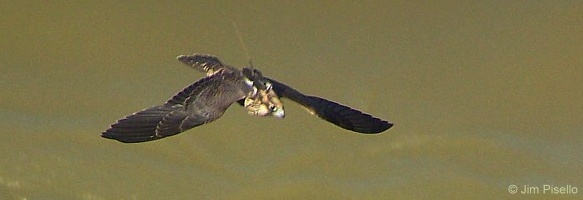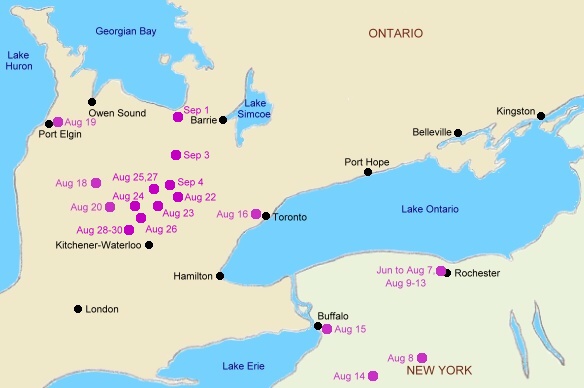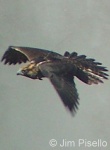|
|
Skye
- hatched in Rochester, New York |

Scroll
down or click here to access the latest reports on
Skye's movements
|
Background:
For the second consecutive year, MRF is proud to be tracking a
juvenile Peregrine Falcon from Rochester, New York, in partnership
with the New York State Department of Environmental Conservation,
Eastman Kodak, and the Genesee Valley Audubon Society. This
year the satellite transmitter is being worn by a female named
Skye. For a detailed account of the movements of Hafoc, the
young male tracked last year, click
here.
The
transmitter worn by Skye is powered by solar energy, and has the potential
to broadcast
for two to three years. Unfortunately juvenile Peregrine Falcons are
known to have an average first-year mortality rate of 60-70%, so
there is no guarantee that our observations will last that long,
though we hope that Skye will defy those odds.
Data received will be summarized on this
page in reverse chronological order on a weekly basis, and at times more
frequently. Maps will be updated as Skye begins to travel further
away from Rochester, as frequently as necessary to illustrate her movements.
The
eastern Peregrine Falcon population has been increasing steadily in recent
years, but remains relatively small, and there is still very little known
about the survival and dispersal of juveniles in particular.
Satellite telemetry provides us a rare opportunity to track in detail the
movements of individual birds to gain insights into some of these
mysteries.
The
combined weight of the transmitter and harness is just over 20 grams,
which is less than 3% of a female Peregrine Falcon's average weight.
It is attached to the bird as a backpack, with the harness made of soft
and flexible neoprene. The harness has been sewn together with
biodegradable thread, which will allow the transmitter to fall off after
approximately two years. Previous studies suggest that even in the
meantime, the transmitter is not expected to influence the bird's
behaviour in any way. For further information on the technical
aspects of satellite telemetry, check out our methods
section and the links contained therein.
|
|
Questions
or comments? Please e-mail MRF Research Director Marcel
Gahbauer.
Tax-deductible donations to support this and other research programs are
greatly appreciated - click here
for more information

(Map updated each weekend)
Reports:
September
17, 2005:
Lucknow, ON.
Although they are not what we were hoping for, a search for Skye has
yielded some results. Skye was found ~15 metres from the last
telemetry location received, though her transmitter itself was not seen.
We
now know more specifics about the location. Skye was within a few
metres of a pond, just inside a recently cut corn field and adjacent to a
field with horses. The nearby road is gravel and lightly traveled,
and it therefore seems unlikely that she suffered a vehicle
collision. Rather, given the condition in which she was found, it
appears she was the victim of predation. One plausible scenario is
that she had caught prey from on/around the pond, and was eating it on the
ground when attacked by a terrestrial predator (fox or coyote most
likely). An older Peregrine Falcon would usually carry prey to a
safe place before eating, but young birds are more likely to make
"careless errors", and sometimes pay the ultimate price for
them.
This
will likely be the final entry on Skye's page. Thank you to all of
our project supporters, and to all of you who have shown an interest in
reading about Skye's travels. Watch the MRF
news page for announcements about other ongoing research and future
projects as they are announced.
September
11, 2005:
Lucknow, ON.
Our tracking of Skye appears to have come to an unexpected and sudden
end. On Wednesday morning we received three consecutive satellite
readings from exactly the same location, spread across three hours.
This was unusual enough, but temperature data received on Thursday
suggested the transmitter was no longer on a live bird. Friday was a
scheduled gap in the transmission, so we had to wait for yesterday's data
to confirm our suspicions - and unfortunately those results were
consistent with the earlier ones.
The
two possibilities are that Skye has died, or that she has somehow shed the
harness and transmitter. Unfortunately, the data do not provide us
any way of distinguishing between these. The harness was designed to
stay intact for at least two years, but we can't rule out the chance that
it could have failed much earlier than expected.
If
in fact Skye has died, there are many potential causes. The current
location of the transmitter is within 100 metres of a road, and factoring
in the error associated with data points, could in fact be much
closer. Juvenile Peregrine Falcons do sometimes get hit by vehicles,
so that is one possibility. West Nile Virus has been recorded in
various parts of Ontario this year, and with the amount of time that Skye
has spent near wetlands, especially while around Luther Lake, it is
possible that she was bitten by infected mosquitoes. It could also
be that like so many other young raptors, she simply was not an efficient
enough hunter, and died of starvation. Other diseases, predation,
errant shots from waterfowl hunters, and other possibilities exist too.
We
will try to locate the transmitter in an effort to resolve these
questions. However, even with the search narrowed down to a radius
of around 100 metres, it can still be a daunting challenge to find such a
small object (especially if the transmitter only is present).
Updates will be posted if we are successful in learning anything further.
September
6, 2005:
Kincardine, ON.
Another move to the west for Skye today, taking her back to the Lake
Huron shoreline. This time she is just outside the town of
Kincardine, south of where she was on her last trip to the lake at Port
Elgin more than two weeks ago.
September
4, 2005:
Luther Lake, ON.
Skye moved around a fair bit over the last week, but eventually ended
up on the opposite side of Luther Lake from where she began. Early
in the week, she moved southwest for three days to a rural area a bit
northwest of Kitchener-Waterloo. The beginning of September
triggered another northward movement, bringing Skye to Collingwood, at the
southern end of Georgian Bay. Her movement in this direction may
have been linked to the strong south winds bringing in the remnants of
Hurricane Katrina. Collingwood has reported irregular Peregrine
Falcon sightings over the past few years, but no nesting attempts have
been documented yet. By yesterday Skye was edging back south again,
hanging around Shelburne, and as of today she was moving back and forth
along the eastern side of Luther Lake. There have not yet been any
major cold fronts, and it will be interesting to see how Skye responds
when one finally passes.
August
27, 2005:
Luther Lake, ON.
Skye seems to have set up at least a temporary home base northwest of
Toronto. For long periods on two of the last three days, she has
been on the west side of Luther Lake, the largest inland wetland in
southwestern Ontario. Much of the lake is shallow and marshy, and it
supports a tremendous variety of breeding waterfowl, several of them found
in few if any other locations in the southern part of the province.
Presumably by stationing herself beside the lake, Skye is taking advantage
of the abundant ducks and other marsh birds, living up to the "duck
hawk" nickname that Peregrine Falcons bear.
August
24, 2005:
Arthur, ON.
For the past four days, Skye has remained within a 25 kilometre radius
of Arthur, Ontario. On August 22 she moved east from her previous
location, approaching Orangeville. However, since then she has
drifted slowly to the west again each day, ending up right in Arthur this
afternoon. Skye is currently less than 50 kilometres north of both
Guelph and Kitchener-Waterloo, both of which are cities which have hosted
Peregrine Falcons on several occasions in recent years, though no nesting
attempts have yet been reported. It would not be surprising to see
Skye pay a visit to one or both locations while she is in the area.
August
20, 2005:
Palmerston, ON.
Severe storms rolled through much of southwestern Ontario yesterday,
including at least one tornado northwest of Toronto and plenty of heavy
rain and winds everywhere. We were curious to learn whether Skye
responded to this by staying put and seeking shelter, or trying to move
away from the bad weather. The answer is that she did in fact start
moving back south, passing by her location from two days ago, and ending
up around Palmerston.
August
19, 2005:
Port Elgin, ON.
A shorter distance traveled by Skye this time around. Of all the
equidistant towns from her last known point, she picked Port Elgin as her
destination. This is along the shore of Lake Huron, not far south of
the Bruce Peninsula, where Peregrine Falcons have begun nesting again in
recent years. Even closer is MacGregor Point Provincial Park, a
known hotspot for birds of all kinds. From here she will either have
to turn back, or set out across the water again. We will boldly
predict a turn to the south ... recognizing that tomorrow Skye could
easily prove us wrong!
August
18, 2005:
Ayton, ON.
Skye has become quite famous in the past few days, with articles in
both the Rochester Democrat & Chronicle and Toronto Star describing
her early travels away from home. Welcome to the readers who are
visiting the MRF website for the first time as a result of these articles!
For
reasons we can only speculate about, Skye has chosen not to stay in
Toronto. In fact, for the moment at least it seems like she has
given up on city life entirely. The latest data to arrive were
collected between 9 pm last night and 5 am this morning. Not
surprisingly, Skye was stationary during this period. She was near
Ayton, Ontario, in a relatively flat and largely agricultural part of the
province. The nearest large towns or cities in any direction are
60-70 kilometres away (Owen Sound to the north, Port Elgin to the
northwest, Goderich to the southwest, Kitchener to the southeast, and
Orangeville to the east). The landscape around Ayton isn't
particularly well suited to a Peregrine Falcon, so chances are good she
will have moved elsewhere again by the time we receive tomorrow night's
update.
Meanwhile,
we have learned that back on August 7, Skye had an adventure of an entirely
different sort while still in Rochester. She walked into a rooftop
pigeon trap on a hospital, and had herself a nice meal ... there were 9
pigeons in the trap when she entered, but only 7 by the time she was
found! Though well-fed, Skye nonetheless was in the same predicament
as the pigeons in that she could not escape - but no doubt experiencing
much less stress than the pigeons, which must have been wondering who
would be the
next meal!. Skye was released unharmed by the monitors checking the
traps (as were the pigeons). Nevertheless, perhaps it is more than
coincidence that it was the following day when she made her first
significant foray away from Rochester! We can only hope she has
learned her lesson and will not put herself in such a position again.
August
16, 2005:
Toronto, ON.
Skye is on the move! Sunday she flew southwest, ending up
roughly 100 kilometres from Rochester, between Lime Lake-Machias and
Houghton. She remained in that area overnight, then on Monday
morning headed northwest and by early afternoon was just southeast of
downtown Buffalo. Whether or not she encountered the local
peregrines there we don't know, but in any event she didn't linger.
Today's reports, spanning a 3-hour period this afternoon, had her
northwest of downtown Toronto, in an area bounded by St. Clair and
Lawrence Avenues to the south and north, and Bathurst and Jane Streets to
the east and west. Toronto currently has at least 5 active peregrine
territories, so Skye may soon find herself an unwelcome intruder in one of
their territories. Even if she does not encounter them, data from
recent days suggest that she is likely to remain on the move.
August
13, 2005:
Rochester, NY.
Again Skye made just one noteworthy trip away from Rochester this
week, but it was a significantly longer one than last time. On
August 8, she spent the afternoon roughly 65 kilometres to the south, in
the area of Nunda, between the Genesee River and I-390. However, the
next day she was back in downtown Rochester again, and has spent the rest
of the week there.
August
8, 2005:
Rochester, NY.
Mostly another uneventful week, but Skye did make at least one foray
further away from home. Satellite reports were received on six of
seven days over the past week, and except on Saturday, Skye remained
within a couple of kilometres of the Kodak nest box, as has been her habit
to date. To our surprise, Friday night found her 20 kilometres to the southeast, along
I-90, midway between the Hwy 96 and Hwy 64 exits. However, it was a
brief trip only, as observers saw her back near the nest already early on
Saturday morning. It seems that Skye is testing
her independence, and we expect her trips away from home to become longer
and more frequent as time goes on.
July
31, 2005:
Rochester, NY.
Another week has passed without Skye making any movements of note
yet. Very strong signals have been received from her transmitter
almost daily, with the most distant of them coming from less than 3
kilometres away from the nest box. However, data from the past few
days suggest that she might be starting to roam at least a bit more.
In the first half of the week she appeared to rarely be out of sight of
the nest, but on Friday she wandered west along Hwy 33 a little, while
yesterday and today she was east along Hwy 36, a bit beyond the Inner
Loop.
July
25, 2005:
Rochester, NY.
As is to be expected from a young bird, Skye is still staying close to
home. She is taking it to an extreme though - on four of the last
five days, the strongest signals from her transmitter have placed her
within one kilometre of the nest box! The one exception was on July
20, when she was along the Genesee River, a bit north of Highway
104. Her very local movements to date suggest that she either
remains dependent on her parents for food, or is simply not ready to
assert her independence fully yet.
July
18, 2005:
Rochester, NY.
We began receiving data from Skye's transmitter five days ago, and the
locations have consistently indicated that she is remaining close to the
heart of Rochester, never yet straying more than 6 kilometres from the
nest site at the Kodak headquarters. What few movements she is
making tend to overwhelmingly be on the east side of the Genesee River,
and mostly heading straight east from the nest. On July 15 we
received a clear report from during the middle of the night which placed
her almost right at the nest, suggesting that perhaps at least part of the
time she still returns 'home' to roost for the night.
Updates
to Skye's position will be posted here approximately weekly, and a map of
her movements will be added at the top of the reports section once she
begins to move outside of the Rochester area.
July
2, 2005:
Rochester, NY.
Skye's transmitter is functioning well, but we are awaiting for
authorizations to clear which will permit the flow of data to us to
begin. Regular updates on Skye will commence on this page around
mid-July.
|



